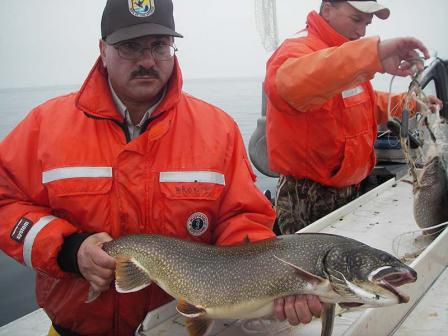Selection
Clarkson University – Great Lakes Fish Monitoring and Surveillance Program (GLFMSP) FY2021-2025 ($5.9 million)
EPA, Members of Congress, Partners and Stakeholders celebrate a decade of GLRI success Dec. 9, 2020
RFA Info
Funding Opportunity Number: EPA-R5-GL2020-FMSP
This Request for Applications (RFA) solicited applications from eligible entities for a cooperative agreement to be awarded pursuant to the Great Lakes Restoration Initiative Action Plan III.
EPA sought applications for a project to monitor the temporal trends of persistent, bioaccumulative, and toxic chemicals in fish in the Great Lakes.
Program Activities
The Great Lakes Fish Monitoring and Surveillance Program (GLFMSP) monitors legacy contaminants and conducts surveillance for contaminants of emerging concern in top predator fish within open lake sampling locations in each of the Great Lakes. These are the two components of the GLFMSP:
Base Monitoring Program
- Sample Analysis – Applicants are expected to analyze all collected composite and individual fish samples for all contaminants on the GLFMSP analyte list:
Required analyte list for sediment samples- PCB congeners and co-planar PCBs
- Total PCBs
- Total HBCD
- Mirex
- Total toxaphene & toxaphene homologs
- PBDE congeners
- Total PBDEs
- Total mercury
- Total DDT
- pp,-DDT
- pp,-DDE
- pp,-DDD
- PBB-153
- PCDD/F congeners
- Total PCDD/Fs
- HBCD
- PFCs including PFOA, PFOS, PFNA, PFHxS, PFHpA, PFBA, PFBS, PFCA
- Lipid fraction
- Omega-3 fatty acids
- Composite sample percent moisture
- Data Management, Interpretation, Statistical Analysis and Reporting – Applicants are expected to manage data generated through sample analysis and submit to EPA. Applicants are expected to interpret data through statistical analysis and report findings to EPA, publish in peer-reviewed venues and contribute to annual GLFMSP technical reports. Any data generated pursuant to this cooperative agreement, if awarded, will be provided to EPA.
- Quality Assurance and Quality Control – Applicants are expected to develop, implement and maintain a Quality Assurance Project Plan (QAPP).
 U.S. Fish and Wildlife Service personnel performing fish collection activities on the Great Lakes.Special Studies/Cooperative Science and Monitoring
U.S. Fish and Wildlife Service personnel performing fish collection activities on the Great Lakes.Special Studies/Cooperative Science and Monitoring
Special studies conducted as part of the GLFMSP support, enhance, and inform the GLFMSP core elements. Examples of the types of special studies may include analysis of chemicals in additional fish species, analysis of archived tissue for new chemicals to identify and confirm trends, comparison of individual and composite GLFMSP fish samples, analysis of chemicals in fish from additional sites, and bioeffects. See Cooperative Science and Monitoring Initiative (CSMI) for more information.
Funding/awards
Under this competition, approximately $6 million may be awarded for one cooperative agreement over a five-year period, consisting of incremental funding of about $1.2 million per year. Proposed projects must be limited to the specified project duration of five years. All incrementally funded awards will be subject to the availability of funding, future appropriations, satisfactory performance of work, and other applicable considerations.
Who can apply
- state agencies,
- interstate agencies,
- federally recognized Indian tribes and tribal organizations,
- local governments,
- institutions of higher learning (i.e., colleges and universities),
- and non-profit organizations as defined in 2 C.F.R. § 200
- individuals
- foreign organizations and governments,
- nonprofit organizations exempt from taxation under Section 501(c)(4) of the Internal Revenue Code that engage in lobbying,
- and “for-profit” organizations
- Great Lakes Fish Monitoring and Surveillance Program 2020 Request for Applications (PDF)(37 pp, 459 K, July 21, 2020)
- Questions and Answers for 2020 Great Lakes Fish Monitoring RFA (PDF)(2 pp, 116 K, Sept. 3, 2020)
